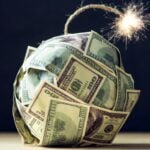
Source: Shutterstock
Editorial Note: InvestorPlace Beacon independently determines what we cover and recommend. We earn a commission from affiliate partners on many offers and links. However, these commissions do not affect our editors' opinions or evaluations. Click here to read our full advertiser disclosure.
High-yield savings accounts became an attractive place to store cash amid soaring interest rates in recent years. But expected changes by the Federal Reserve could lead to banks cutting those impressive rates, and consumers earning less on their savings.
Despite their ability to generate returns on cash while giving you easy access to your money, are high-yield savings accounts losing their luster?
What Is a High-Yield Savings Account?
A high-yield savings account is a type of savings account that provides a higher annual percentage yield (APY) than a traditional savings account — sometimes up to 12 times the average interest rate of traditional savings accounts.
Money deposited into a high-yield savings account earns interest based on the current APY offered by the bank or credit union. This is a variable rate, meaning that it can change at any time. Financial institutions tend to increase or decrease the rates on high-yield savings accounts and other accounts based on changes to the federal funds rate set by the Federal Reserve. When the Fed hikes the federal funds rate, banks usually hike the rates on high-yield savings accounts, and vice versa.
Like other deposit accounts, high-yield savings accounts are typically insured by the Federal Deposit Insurance Corporation (FDIC) or the National Credit Union Administration (NCUA). This means that funds in these accounts are protected up to $250,000 per depositor per account in the case that a financial institution collapses.
Online banks and credit unions are usually able to offer higher APYs on their savings accounts than traditional brick-and-mortar institutions, since they can pass their low overhead to customers in the form of interest.
What Are the Benefits of a High-Yield Savings Account?
High-yield savings accounts are especially beneficial when you want to earn interest on your cash but also want to maintain easy access to your money. Certificates of deposit (CDs) require you to lock up your money for a certain length of time, and money invested in the stock market should be for longer-term goals. But a high-yield savings account can be especially beneficial for:
- Short-term savings: With a high-yield savings account, you can easily grow your funds with interest while saving for an upcoming vacation or a down payment for a new home you’re planning to buy in the near term.
- Emergency fund: Financial advisors tend to recommend setting aside money that could cover three to six months of your expenses in the case of an emergency, like job loss. You can use a high-yield savings account to safely grow your emergency fund with the peace of mind that the money is easily accessible if and when you need it.
Just be sure to keep an eye on interest rates as they can fluctuate. If inflation outpaces the interest on your account, you could end up losing spending power.
The Current State of High-Yield Savings Accounts
Factors like inflation and the state of the labor market can all impact whether the federal funds rate is made higher or lower, which in turn affects rates on high-yield savings accounts.
In an effort to curb decades-high inflation, the Federal Reserve implemented steady rate increases in 2022 and 2023 that mark its fastest pace of rate hikes since the 1980s. In 2024, the Fed has held rates steady at a range of 5.25% to 5.50% as it continues to battle high consumer prices.
But rates aren’t expected to stay this high forever. The Fed has suggested there could be three rate cuts this year — though there is no certainty this will happen, especially as inflation stays stubborn.
If the Fed were to lower interest rates this year, banks and credit unions would likely follow suit and lower the interest rates on high-yield savings accounts.
Alternatives to a High-Yield Savings Account
While a high-yield savings account makes sense for short-term savings and emergency funds, it’s not your only option. High-yield savings account alternatives include:
- Checking accounts: A checking account rarely earns enough interest to compete with a high-yield savings account, but it is a convenient vehicle to store and access your funds on a regular basis. A debit card and high daily spending limits are some of the extra features you will get with this type of account.
- CDs: A certificate of deposit is similar to a savings account, but it allows you to earn a set interest rate for a predetermined period of time (typically between three months and five years). Like high-yield savings accounts, CDs have especially high rates right now that make them an attractive alternative to a high-yield savings account.
- Money market accounts (MMAs): If you are looking for something between a savings and checking account, you may want to consider a money market account. These accounts often come with a debit card and checks for convenient access to your funds like checking accounts, but they also earn a higher interest rate than your average savings account.
Is a High-Yield Savings Account Worth It?
A high-yield savings account is designed to help you increase your savings much more quickly than you would with a traditional savings account. Interest rates vary, but the best high-yield savings accounts offer APYs of 5% and more with no or low fees.
However, these accounts don’t offer as much earning potential as investing your money in the stock market — and there’s a good chance their rates will drop in the near term. While a high-yield savings account can be a good place to store your cash, they shouldn’t replace investing for the long term via the financial markets.
Sources
Federal Deposit Insurance Corporation. (2024, April 23). National Rates and Rate Caps. Retrieved from https://www.fdic.gov/resources/bankers/national-rates/index.html.
Federal Deposit Insurance Corporation.(2024, April 22). Deposit Insurance FAQs. Retrieved from https://www.fdic.gov/resources/deposit-insurance/faq/index.html.
Board of Governors of the Federal Reserve System. (2024, April 22). FAQs. Retrieved from https://www.federalreserve.gov/faqs/money_12856.htm.
Federal Deposit Insurance Corporation. (2024, April 23). Summary of Economic Projections. Retrieved from https://www.federalreserve.gov/monetarypolicy/files/fomcprojtabl20221214.pdf.



